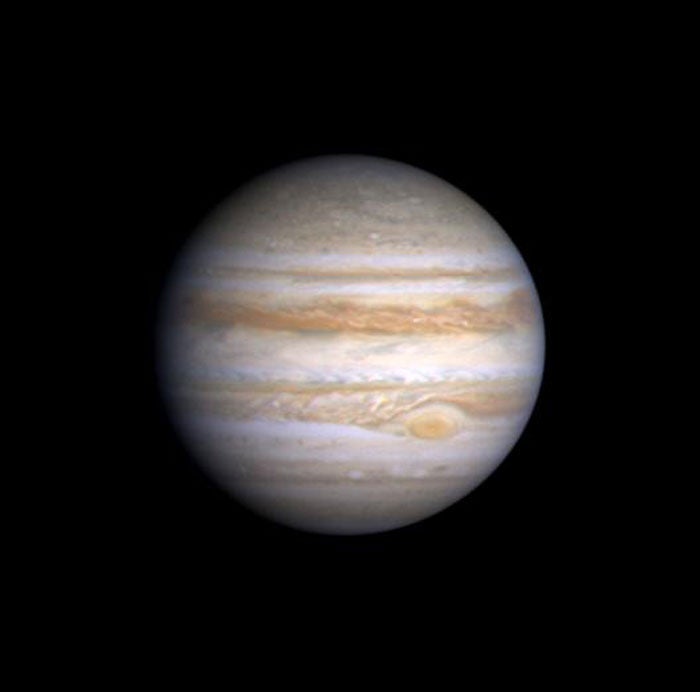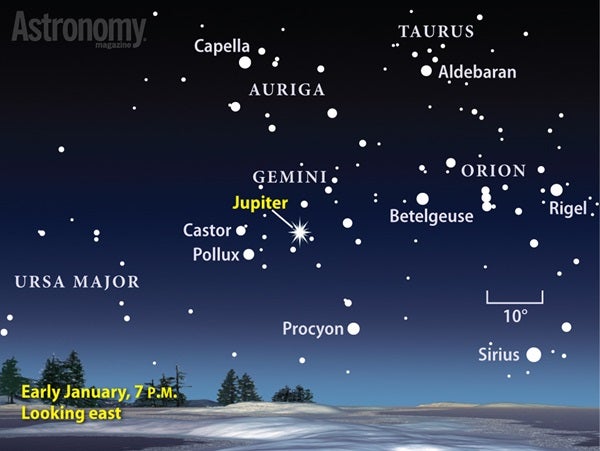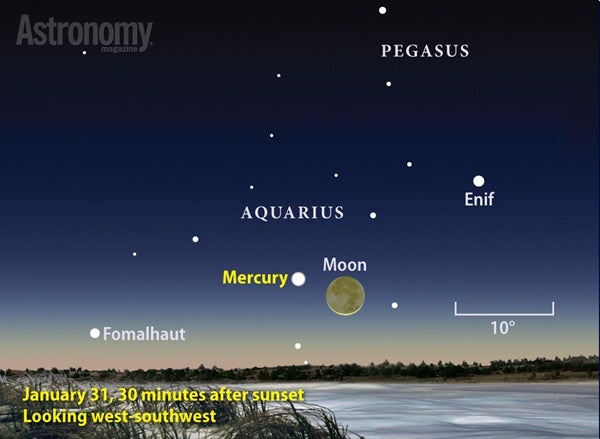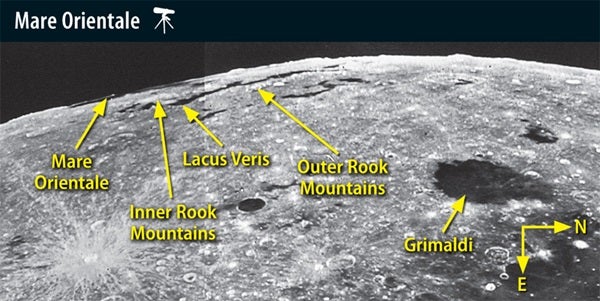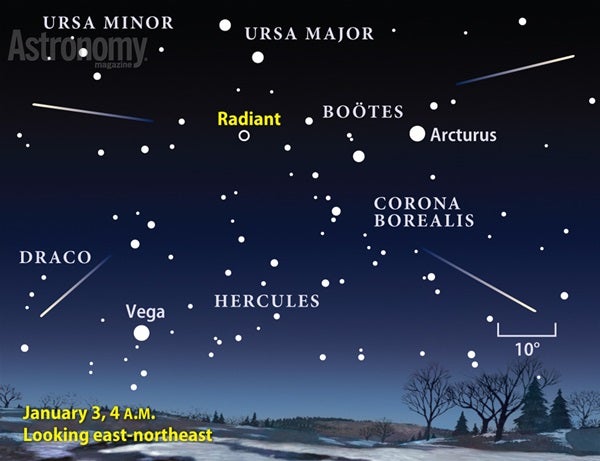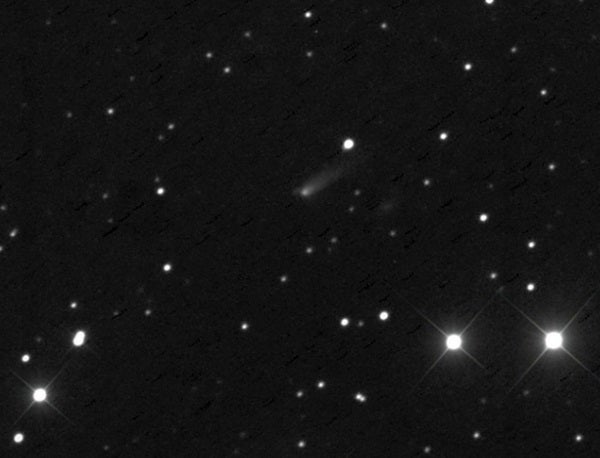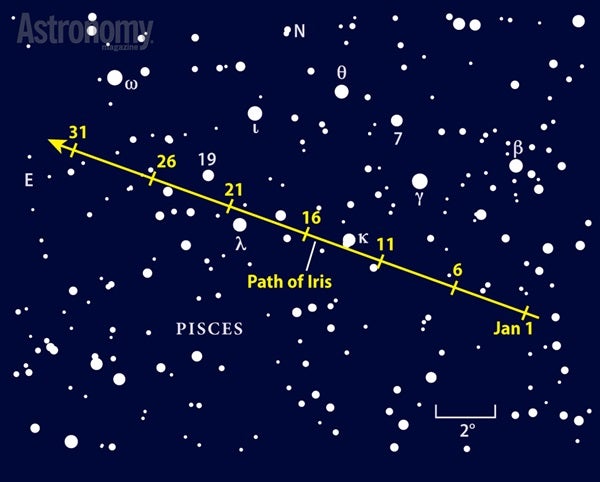There’s lots of action in the planetary arena this month. At the top of the list is Jupiter, which appears better than it has in 13 months and remains on display all night. Venus, the only planet that outshines Jupiter, hangs low in evening twilight in early January and then reappears in the morning sky after midmonth. Once Venus exits the evening stage, Mercury arrives with a fine performance of its own late in the month. Not to be outdone, both Mars and Saturn improve noticeably as they climb high before dawn.
Let’s begin our tour of the sky shortly after the Sun sets January 1. Venus shines at magnitude –4.4, a brilliant jewel nearly 10° above the southwestern horizon 30 minutes after sunset. Use Venus as a guide for finding an exceptionally young Moon. From mid-northern latitudes, our satellite sets just 45 minutes after the Sun. And from North America’s Central time zone, the Moon is then just 15 hours past its New phase and only 0.6 percent lit. With binoculars, scan the area to the lower right of Venus and just above the horizon. You’ll need a crystal-clear sky and an unobstructed western horizon to spot the difficult crescent.
A view of Venus through a telescope shows a disk not much more illuminated than the Moon’s. On the 1st, it appears 60″ across and only 3 percent lit. By January 5, just six days before Venus passes between the Sun and Earth, the inner planet stands 4° high a half-hour after sunset. A scope reveals Venus’ 62″-diameter disk, which appears a mere 1 percent lit.
After passing 5° north of the Sun at inferior conjunction January 11, Venus switches to the morning sky. By the 17th, the planet comes up in the east-southeast a full hour before the Sun, and by the 31st, this gap stretches to two hours. Venus crosses from northern Sagittarius to southern Scutum and back during January’s final week. Look for the waning crescent Moon near the planet both January 28 and 29. On the month’s final morning, Venus shines at magnitude –4.8 and a telescope shows a disk that spans 52″ and appears 12 percent lit.
Mercury doesn’t come into view until mid-January, when it starts what will be one of its two best evening appearances of 2014. As it initially climbs into view after sunset, the innermost planet shines at magnitude –1.0; through a telescope, it shows a nearly full disk that spans 5″.
Mercury reaches greatest elongation January 31, when it lies 18° east of the Sun. It then appears 11° high in the west-southwest 30 minutes after sunset and, at magnitude –0.7, stands out through binoculars to anyone with a clear and unobstructed horizon. A telescope reveals the planet’s 7″-diameter disk, which appears slightly over half-lit.
Earth’s Moon takes 29.5 days to complete its cycle of phases, so it shouldn’t come as a surprise that a young Moon returns to the evening sky at the end of January. You can find our satellite 5° to Mercury’s lower right on the 31st. The Sun then illuminates 2 percent of the Moon, so it still will be a challenge to spot without binoculars.
A much fainter planet also lurks in Mercury’s vicinity January 31. Distant Neptune lies 4° east of the inner planet. (Mercury lies near the center of a line joining the Moon and Neptune.) Spotting Neptune during twilight is tricky, and the sky doesn’t darken completely until the planet is on the verge of setting.
The outer world is much easier to find in early January, when it appears 25° high after twilight has faded away. You can locate the 8th-magnitude world through binoculars among the background stars of Aquarius the Water-bearer. January 4 offers a good opportunity. The waxing crescent Moon then lies 1.9° north of 4th-magnitude Theta (θ) Aquarii while Neptune resides 3.4° south-southeast of the same star. The planet looks like a double star through binoculars from January 10 to 15 when it passes within 5′ of a magnitude 7.7 background sun. Neptune slides 2.8′ due south of this star January 12.
Neptune’s sister world, Uranus, stands much higher in the evening sky. It sets near midnight local time in early January and around 10 p.m. at month’s end, providing several hours for binocular observers to track it down. The magnitude 5.9 planet wanders slowly to the east-northeast in southern Pisces, some 6° southwest of 4th-magnitude Delta (δ) Piscium. A telescope at medium magnification reveals the planet’s 3.5″-diameter disk and blue-green color.
As twilight descends these cold winter nights, you easily can spot Jupiter climbing in the east. The giant planet reaches opposition and peak visibility January 5 among the background stars of central Gemini. It then rises at sunset and passes nearly overhead around midnight local time for observers at mid-northern latitudes. Jupiter shines brilliantly at magnitude –2.7, which makes it the brightest point of light in the sky whenever Venus is out of sight.
Around opposition, Jupiter remains above the horizon for at least 12 hours — two hours longer than its own rotation period. This provides a perfect opportunity to view the entire dynamic planet in a single night. An alternating series of bright zones and dark belts stands out on its 47″-diameter disk. If you don’t see the Great Red Spot right away, it simply may be on the planet’s far side. Wait a few hours, and it should rotate into view.
Jupiter’s four bright moons provide plenty of action to fill these chilly nights. On the night of opposition, all four appear as points of light arrayed on either side of the planet. As a bonus, they appear in order of their distance from Jupiter, with Io closest, followed by Europa, Ganymede, and Callisto.
Many observers enjoy watching the moons and their shadows cross Jupiter’s face. Several such transits occur in January. For North Americans, Europa puts on a fine show after sunset January 8. The moon first touches the planet’s disk at 6:48 p.m. EST, followed by the shadow 10 minutes later. The moon clears the jovian disk at 9:29 p.m. EST, and the shadow leaves at 9:40 p.m. Io performs a similar maneuver January 13, with the innermost moon crossing between 6:22 p.m. and 8:38 p.m. EST and its shadow between 6:35 p.m. and 8:50 p.m. EST.
The geometry between Earth, Jupiter, and the Sun constantly changes as the planets orbit our star, and this shows up in the timing of satellite events. For example, when Io transits January 27, the moon starts crossing at 9:51 p.m. EST and the shadow follows 33 minutes later.
Not long after the fireworks die down on New Year’s Eve, Mars pops above the eastern horizon. The Red Planet rises just 10 minutes or so after midnight January 1 and nearly two hours earlier by month’s end. On the 1st, it glows at magnitude 0.8 some 1.4° southeast of 3rd-magnitude Gamma (γ) Virginis. The planet moves eastward during January and closes the month 5° north of 1st-magnitude Spica, the Maiden’s leading star. During January’s 31 days, the Red Planet brightens by half a magnitude, so it noticeably outshines the star.
By the end of January, Mars’ apparent diameter reaches 9″, big enough to show modest detail through 8-inch and larger telescopes. The best views of the planet will come in the two hours before twilight starts to paint the sky, when it appears at least 40° above the horizon. The higher altitude lessens the blurring effects of Earth’s atmosphere.
The hour or so before twilight begins is also the best time to view Saturn. The ringed world stands out in the southeast against the backdrop of Libra the Balance. Saturn shines at magnitude 0.6, two magnitudes brighter than any of Libra’s stars. The planet measures 16″ across its equator at midmonth while the rings span 37″ and tilt 22° to our line of sight.
As January draws to a close, take note of all three bright morning planets. They offer a wide variety of wonder for planetary viewers — the changing phases of Venus, the stunning rings of Saturn, and the ruddy desert plains of Mars. It marks a great start to a new year of observing.
GET A GLIMPSE OF THE ORIENT
The Moon’s most striking impact basin is arguably Mare Orientale, a sea of lava surrounded by a huge, well-defined double ring of rugged mountains that spans nearly 600 miles. Don’t fret if you haven’t heard of it — it’s tucked against the western limb of the Moon. Only its eastern ramparts and lava lakes show up, and these only when the lunar spin and elliptical orbit align. Such a favorable tilt (or “libration”) occurs from January 20 to 27.
Orientale is all about observing at the edge. Before the 20th, the raised rim of the Cordillera Mountains appears in profile as a pair of ears poking above the western limb. Use the dark crater Grimaldi to orient yourself. The rim edges separate night to night until the 19th, when the long dark line of Lacus Veris tilts into view. You’re now looking beyond the tall ring of the outer Rook Mountains, first into the shallows where lava welled up from below and then to the light colors of the lunar crust that push up into the inner Rook Mountains.
To spy Mare Orientale’s dark central floor, try the mornings of January 23 to 25 when the libration maxes out. Astronomers deduce that when Orientale formed, the denser mantle underneath bulged upward. This created a mass concentration, and the extra gravitational force produced by this so-called mascon slightly alters the orbits of spacecraft.
The angle of incoming sunlight makes all the difference when it comes to lunar observing. The picture here shows the back inner wall of Orientale as a thin white line on the limb under a late morning Sun’s illumination. If it were late afternoon, when the Moon appears to us as a thin crescent, that wall would be in shadow and provide no help in tracing the outline of this giant impact feature.
PERFECT CONDITIONS FOR THE 2014 QUADRANTIDS
January’s claim to meteor fame is the annual Quadrantid shower. Although activity varies from year to year, the rate usually peaks above 60 meteors per hour under ideal conditions and often goes twice that high. The meteors appear to radiate from a point in northern Boötes.
The Quadrantids reach a sharp peak in the predawn hours January 3. With New Moon arriving January 1, conditions should be excellent, assuming January’s often fickle weather cooperates. For the best views, find an observing location far from city lights.
For a time in 2013, the Internet was abuzz with the idea that Earth might get a new meteor shower this month. In mid-January, our planet comes close to where Comet ISON (C/2012 S1) was during November. Some people thought we’d get a show when Earth forged through the comet’s dusty debris. Astronomers are skeptical, however, that the passage will deliver any meteors. Still, observers are keeping their fingers crossed and plan to see what develops.
| WHEN TO VIEW THE PLANETS |
||
| Evening Sky |
Midnight | Morning Sky |
| Mercury (west) |
Mars (east) |
Venus (southeast) |
| Venus (southwest) |
Jupiter (southwest) |
Mars (south) |
| Jupiter (east) |
Jupiter (northwest) |
|
| Uranus (southwest) |
Saturn (south) |
|
| Neptune (southwest) |
||
ISON BIDS A FOND FAREWELL
Assuming Comet ISON (C/2012 S1) survived its close pass by the Sun in late November, it should be set to deliver a lovely encore in January’s sky. ISON’s broad fan tail will transform quickly into a sharp sword as Earth swings through the comet’s orbital path in mid-January, treating us to a bright anti-tail.
ISON belongs to both the evening and morning skies this month because it passes close to Polaris. Because the North Star never sets for observers north of the equator, the comet remains visible all night. To see ISON best, find a dark observing site and sidestep moonlight. In early January, dark skies come in mid- to late evening after the Moon sets. During the month’s second week, the waxing Moon demands a switch to predawn hours. Once past its Full phase, our satellite rises later, so you can return to evening viewing.
As January begins, we see ISON almost broadside, with its tail spread into a wide fan. This happens because most of the ejected dust lies along a sheet matching the comet’s orbit around the Sun. But our viewing angle changes quickly. By the night of January 15/16, Earth passes through this sheet. We get an edge-on perspective, and the fan sharpens into a long blade. Watch the night-to-night transformation during the month’s second week.
Despite the inescapable Full Moon, try hard to observe during these edge-on nights. In a trick of perspective, ISON should sport a bright anti-tail, one that points toward the Sun and not away. If ISON continues to produce a significant amount of gas, a blue or green ribbon of light should overlay the “normal” tail that points away from our star. Don’t let city skies stop you from checking out the show. A 4-inch or larger scope should let you witness the dust tail’s transformation into an anti-tail.
ISON will test your star-hopping skills later in the month as it glides from the barrens of northern Cepheus into the confusing constellation Camelopardalis the (nearly invisible) Giraffe. On January 18 and 19, the dirty snowball should glow around 8th magnitude as it passes the large, low-surface-brightness spiral galaxy IC 342. And enjoy the delightful treat on the 24th when ISON crosses Kemble’s Cascade, a pretty star chain that flows into the sparkling star cluster NGC 1502. Finally, the comet’s tail likely will wipe out the well-defined planetary nebula NGC 1501 the night of January 26/27. For more information on observing this celestial visitor during January, see “Comet ISON’s final stab at glory” on p. 56.
IRIS KEEPS AN EYE ON PISCES’ CIRCLET
Asteroid 7 Iris threads a celestial ring this month when it pierces the Circlet asterism in Pisces the Fish. This region lies in the southwest after darkness falls, below the conspicuous Great Square of Pegasus. The surest way to confirm a sighting of this 10th-magnitude object is to detect its motion relative to the background stars. From the suburbs, a 4-inch scope will do the trick.
To differentiate Iris from the look-alike stars along its path, first sketch a framework of three or four dots representing the surrounding star field. Identify the western edge of the sketch by watching which side the stars disappear out of the field of view. Return with your drawing on another night to see which mark changed position. If you want to see Iris move in a single evening, January 14, 15, 17, 19, and 21 provide excellent patterns that are easy to get to from either Kappa (κ) or Lambda (λ) Piscium.
While you’re in the neighborhood on the 23rd, stop off at the guide star 1° north of Iris. Soak in the lovely peach to pale-orange color of 19 Piscium, an irregular variable star that also carries the designation TX Psc. Although trained eyes can detect its half-magnitude wavering, we’re here just to admire its beautiful hue.
English observer John Hind discovered Iris in 1847 almost 50 years after Italian astronomer Giuseppe Piazzi found 1 Ceres. Astronomers named Iris after the Greek goddess of the rainbow. This was the first of Hind’s 10 asteroid discoveries, all of which he found by searching for objects that moved against the background of “fixed” stars.
Martin Ratcliffe provides planetarium development for Sky-Skan, Inc. from his home in Wichita, Kansas. Meteorologist Alister Ling works for Environment Canada in Edmonton, Alberta.

